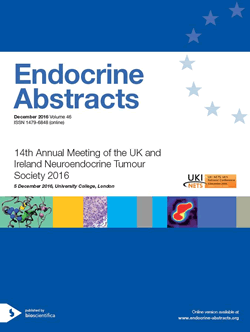Searchable abstracts of presentations at key conferences in endocrinology
14th Annual Meeting of the UK and Ireland Neuroendocrine Tumour Society 2016
What's new in NETs? ENETS guidelines update (new recommendations applied to interactive cases), UK epidemiology and genetics
ea0046nets1 | What's new in NETs? ENETS guidelines update (new recommendations applied to interactive cases), UK epidemiology and genetics | UKINETS2016
(Guidelines) update on small bowel NETs
With the ENETS guidelines update, there are a number of key issues tackled with this common subtype of NET. Terminology is clarified. Whether one uses neuroendocrine tumour, or neoplasm, as mentioned in the guidelines, the terms midgut or hindgut are thought not to be as helpful as indicating the primary anatomical site e.g. jejuno-ileal, rectal, colonic, caecal, appendiceal, etc.Grading with Ki-67 proliferation index, assessed fr...
ea0046nets3 | What's new in NETs? ENETS guidelines update (new recommendations applied to interactive cases), UK epidemiology and genetics | UKINETS2016
Bronchial NETs
The incidence and prevalence of well-differentiated Bronchial NETs has been increasing globally in recent years. This may be due to better diagnostic/detection techniques and a greater awareness of these conditions. Despite this, these cancers are still uncommon and therefore most clinicians will not manage many of these patients. As a consequence, gaining experience in treating these cancers can become challenging. In the absence of a move to centralise their care, guidelines...
ea0046nets5 | What's new in NETs? ENETS guidelines update (new recommendations applied to interactive cases), UK epidemiology and genetics | UKINETS2016
Where NETs fit in with the 100,000 genome project
Genomics England with the consent of participants and the support of the public is creating a lasting legacy for patients, the NHS and the UK economy, through the sequencing of 100,000 genomes. 50,000 genomes from cancer, two per patient (tumour and a paired blood sample) and 50,000 from rare disease, three genomes per patient (affected person plus two blood relatives). The main project started sample collection in March 2015, aiming to collect samples by the end of 2017 throu...




